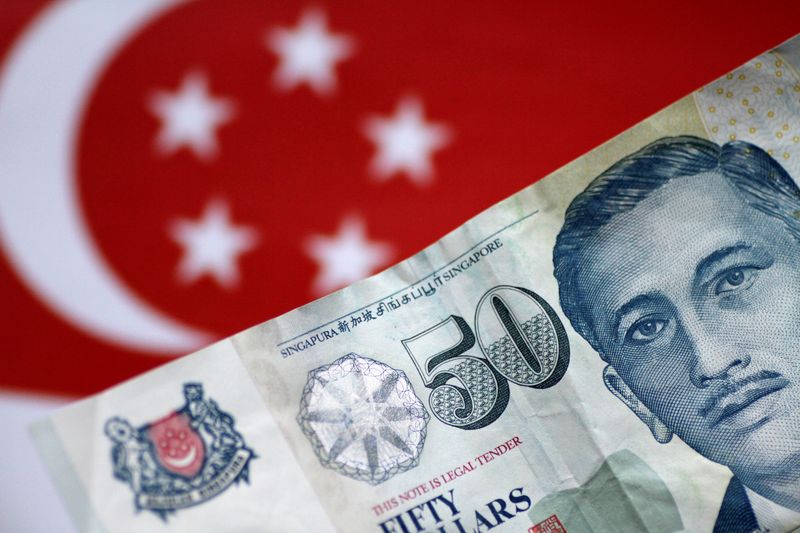 © Reuters. FILE PHOTO: A Singapore dollar note is seen in this illustration photo May 31, 2017. REUTERS/Thomas White/Illustration
2/4
© Reuters. FILE PHOTO: A Singapore dollar note is seen in this illustration photo May 31, 2017. REUTERS/Thomas White/Illustration
2/4
By Upasana Singh
(Reuters) - Investors were most bullish on the Singapore dollar and the Thai baht since the Russia-Ukraine conflict broke out in February, as China easing its strict COVID curbs and hopes of major central banks tempering the monetary policy lifted sentiment, a Reuters poll showed.
Long positions on most other emerging Asian currencies also firmed, with those on the Malaysian ringgit and South Korean won at around two-year highs, a fortnightly poll of 10 analysts showed.
Elsewhere, sentiment on China's yuan was mostly neutral, while investors turned bullish on the Philippine peso for the first time since July 2021.
The poll was conducted before the U.S. Federal Reserve's widely expected 50 basis points interest rate hike on Wednesday – a slowdown after four straight 75 bps hikes – that came with a caveat of the need for further rate hikes despite the risk of a recession.
"Ongoing rate hikes from the Fed will mean that central banks in Southeast Asia will keep raising rates as well," said Poon Panichpibool, a market strategist with Krung Thai Bank.
"But for most (regional) central banks, the pace of raising rates could be slower than their previous hikes because they do not see a lot of pressure from weakness in their local currency right now."
Long positions on the Thai baht were at their highest level since late February, while those on the Singaporean dollar were highest since early February.
Panichpibool expects the baht to be "much stronger" than its current level of 34.76 per dollar by the end of the first quarter of 2023, though the risk of a U.S. recession was a medium-term risk.
Investor appetite for risky Asian assets further improved recently after China, the region's largest trading partner and a manufacturing powerhouse, began easing its stringent domestic zero-COVID curbs, which helped the outlook for regional growth.
"The slowdown in Chinese growth has been one of the largest drivers for dollar strength. A turnabout of that impulse should benefit high-beta, risk-sensitive and commodity-linked FX," Barclays (LON:BARC)' analysts wrote in a note.
Investors marginally cut their short positions on the Indonesian rupiah and the Indian rupee, though both remained the most shorted, by a healthy margin, among the nine regional currencies in the poll.
The rupiah and the rupee are among the worst performers in the region so far this year, heading for declines of 8.8% and 10%, respectively.
DBS analysts expect the rupee to consolidate between 80 and 84 per dollar by 2024, and the rupiah to stabilise between 15,000 and 16,000 per dollar over the next two years.
The Asian currency positioning poll is focused on what analysts and fund managers believe are the current market positions in nine Asian emerging market currencies: the Chinese yuan, South Korean won, Singapore dollar, Indonesian rupiah, Taiwanese dollar, Indian rupee, Philippine peso, Malaysian ringgit and the Thai baht.
The poll uses estimates of net long or short positions on a scale of minus 3 to plus 3. A score of plus 3 indicates the market is significantly long the U.S. dollar.
The figures include positions held through non-deliverable forwards (NDFs).
The survey findings are provided below (positions in U.S. dollar versus each currency):
DATE USD/CNY USD/KRW USD/SGD USD/IDR USD/TWD USD/INR USD/MYR USD/PHP USD/THB
15-Dec-22 0.08 -0.55 -0.85 0.92 -0.22 0.63 -0.36 -0.15 -0.69
1-Dec-22 0.63 -0.15 -0.3 1.08 0.15 0.76 -0.02 0.33 -0.16
17-Nov-22 0.74 0.21 -0.06 1.06 0.84 1.13 1.18 0.89 0.4
03-Nov-22 1.81 1.38 0.47 1.57 1.81 1.47 2.02 1.36 1.34
20-Oct-22 1.96 2.02 1.13 1.83 1.98 1.60 2.33 1.94 2.00
06-Oct-22 1.94 2.25 1.53 1.86 2.12 1.55 2.22 2.16 2.08
22-Sept-22 2.09 2.39 1.61 1.35 2.37 1.23 1.90 1.94 1.86
08-Sept-22 2.04 2.33 1.54 1.13 1.93 1.35 1.89 1.70 1.59
25-Aug-22 1.68 1.85 1.12 1.03 1.53 1.31 1.90 1.38 1.28
11-Aug-22 0.86 1.10 0.51 0.83 1.14 1.00 1.41 0.88 0.87

